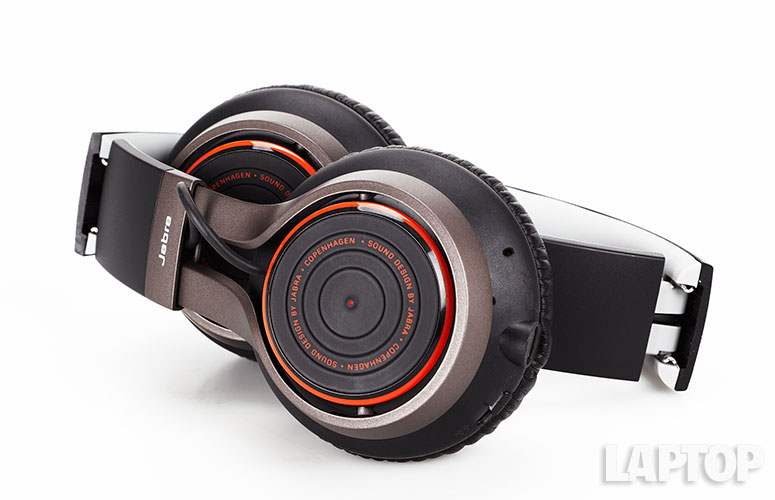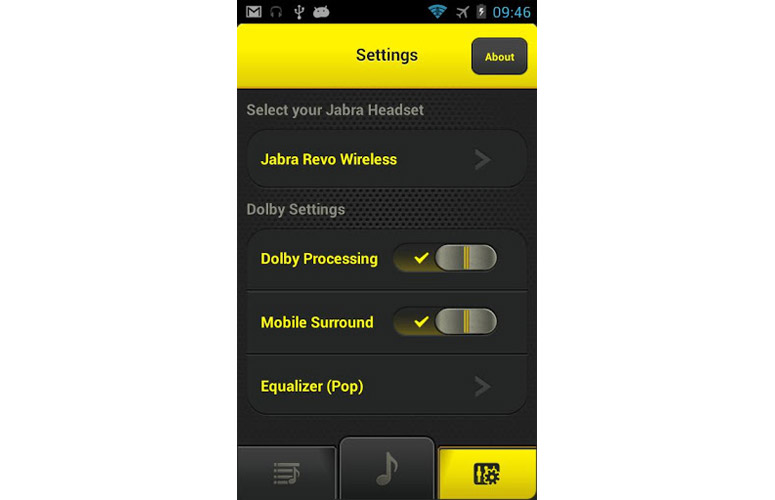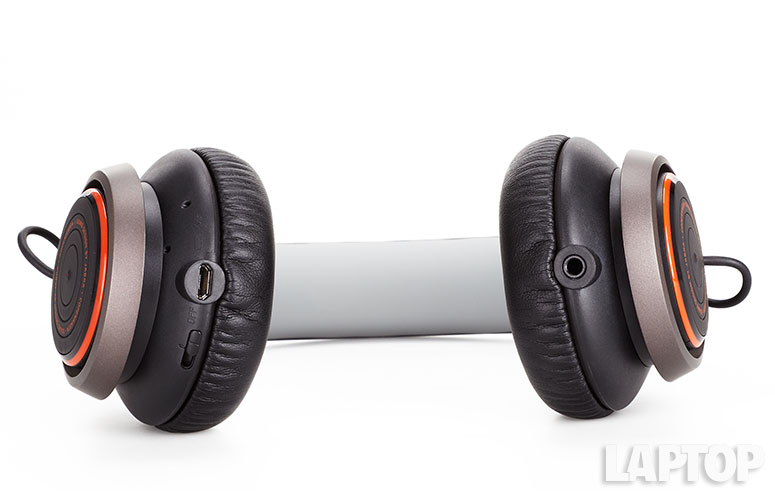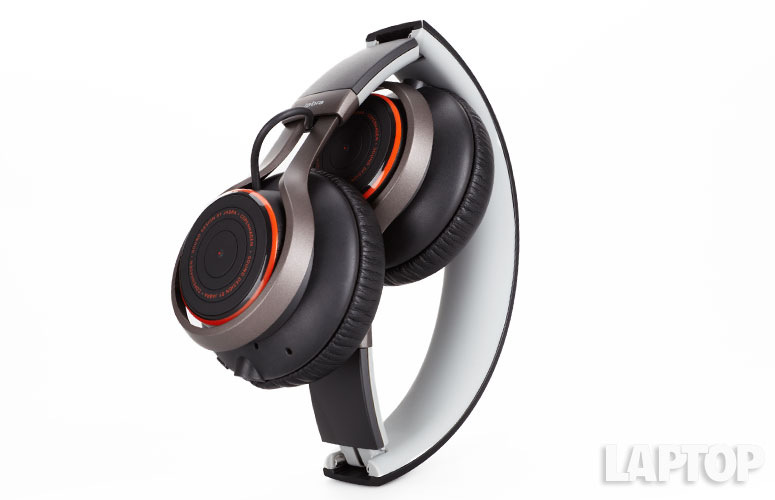Laptop Mag Verdict
The Jabra Revo Wireless deliver big audio for those looking to cut the cord, plus touch controls and a free app for fine-tuning your music.
Pros
- +
Funky, durable design
- +
Responsive, capacitive touch panel
- +
Quick NFC pairing
- +
Free app enhances sound
- +
Long battery life
Cons
- -
Bass-heavy
- -
Large suite of equalizers can be overwhelming
Why you can trust Laptop Mag
Jabra's new Revo Wireless Headphones hit the sweet spot for high-tech features and audio quality. The $249 headphones deliver big sound with capacitive touch controls and NFC inside a fun, durable design. There's also a free app that further enhances the sound. Read on to learn why the Revos can dubstep with the big boys in the wireless headphone market.
Design

Click to EnlargeThe Revos are a slick-looking pair of headphones. The matte black band with a reinforced aluminum frame looks modes but feels sturdy. A pair of strong steel hinges along the interior of the band enables easy folding. The cans are made of soft-touch rubber designed to mimic an old-school turntable. A glossy orange strip along the outer rim gives the headphones a fun pop of color.
The left earcup houses the NFC chip, while the right one houses a capacitive touch panel for controlling the headphones. An On/Off switch and a microUSB slot sit along the bottom of the right can. The left earcup holds a port for the included 3.5mm neon orange audio cables.
The 8-ounce, 7 x 6.29 x 2.87-inch on-ear Revos are lighter than the Parrot Ziks (7.8 x 5.9 x 3.14 inches). We wore the Revos comfortably for hours at a time, thanks to the memory-foam-wrapped ear pads. However, we preferred the Parrot Ziks overall, which fit over our ears instead of on top of them.
Features

Click to EnlargeSimilar to the Parrot Ziks and the Velodyne vFrees, the Revos have a few tricks up their stylish sleeves. We traced a clockwise circular pattern on the right earcup to raise the volume and a counterclockwise pattern to lower the audio. Skipping tracks involved a quick double tap along the front or the back of the cup.
The center multifunction area of the right cup acts as a Play/Pause button as well as an Answer/End Call button. A one-second press of the button rejects phone calls while a double tap activates redial.
In addition to the NFC chip, the left earcup also features a center button that activates the Jabra Sound App on your phone.
Setup
For NFC-equipped devices such as the Lumia 920 and the Samsung Galaxy Note II, pairing the Revo Wireless Headphones couldn't be easier. We enabled NFC and held the handsets to the left earcup. A pop-up notification appeared on each phone asking if we wanted to pair.
When we paired the iPhone 4 and the Lenovo IdeaPad Y500 to the Revos, we held the On/Off/Pairing button in the On position for 3 seconds. From there, a blue LED light flashed and a pleasant female voice informed us that our device was now connected.
The Revos can be paired to two devices at a time. This came in handy when waiting for a phone call while simultaneously streaming music from our PC.
Jabra Sound app

Click to EnlargeThe Jabra Revo Wireless On-Ear headphones have a complementary app called Jabra Sound for Android and iOS. The free app uses Dolby Digital Plus technology to enhance your music-listening experience.
In addition to Dolby's technology, Jabra Sound features Mobile Surround Sound and 17 equalizer presets, including Jungle, Speech, Rock and Latin. The app pulls in your phone's music collection and allows users to create playlists within the app. Jabra Sound also uses any available album art, popping it into a fun CD cover template.
Before we could start using the app, we were prompted to enter an activation code that's included in the packaging. We wish that Jabra had preloaded the PIN onto the headphones. Making users hang on to a small slip of paper to use an app is rather annoying.
We appreciate Jabra's expansive equalizer offering; We spent a lot of time cycling between equalizers trying to find the right one for an individual track. For example, Axl Rose's vocals on "Welcome to the Jungle" sounded rather tinny on the Rock setting. We got a better result using the Jungle equalizer. It was difficult to find an equalizer that could work with a number of different music genres.
The Parrot Audio Suite app for the Ziks offers a more manageable seven equalizers and allowed us to adjust the soundscape and speaker angle. Once we chose our soundscape and the angle, it didn't take long to find a preset that delivered a balanced sound over different genres.
Audio

Click to EnlargeTouch controls, apps and funky design are nice, but it's the audio that counts. The Revos pack quite a punch in the bass department. The lows were warm, rich and often the first thing we noticed on tracks. However, the bass could be overbearing, overshadowing the rest of the track.
For instance, Floetry's "Butterflies" sounded more like a trunk-rattling hip-hop track than a sweet R&B ballad. The violin and piano chords fell flat and the vocal sounded somewhat detached from the rest of the track. When we listened to the same song on the Parrot Ziks, the track wasn't as loud as on the Revos, but the audio was clearer and crisper, especially the cymbals (which were lost on the Revos).
We had a better experience with the Revos when we switched to Bon Jovi's "Living On A Prayer." The lead vocal was a little crisp, as was the triangle and drums. However, the guitar and the bass were muddy.
Noise cancellation
The Revos feature two pairs of microphones with Jabra's Noise Blackout technology and Digital Signal Processing that add noise reduction on digitized audio signals.
When we turned on the headphones, the world faded into the background, leaving only faint voices. And this was before we actually played some music. We were glad that the Revos didn't give us any white noise, an issue we encountered with the Parrot Ziks.
Headset mode
Phone calls made with the Jabra Revo Wireless On-Ear Headphones were clear as a bell on both ends of the line. The active noise-canceling blocked out most of the ambient New York City street noise.
Battery life and Bluetooth range
According to Jabra, the Revos' Lithium-ion battery can last up to 12 hours. During our testing, which consisted of continuous music streaming on Pandora, we saw 11 hours and 46 minutes of battery life. Recharging the battery took about 2 hours and 15 minutes.
Most Bluetooth products have a range of approximately 30 feet. However, we were able to walk 75 feet away (in a straight line) from our Nokia Lumia 920 before the audio cut out.
Verdict

Click to EnlargeJabra manages to squeeze a lot of features into the Revo Wireless Headphones' sturdy, lightweight frame. The capacitive touch panel is responsive and easy to master, and the NFC chip makes pairing with compatible phones quick and painless. The app is simple to use, and the Dolby Digital Plus tech can help you find your ideal preset, even though you need to dig around.
However, while the Revos deliver loud and rich audio, tracks can get bogged down in base. Audiophiles that want crisper, cleaner audio will want to get an earful of the $399 Parrot Ziks. However, for $249, the Revos are an excellent choice for wireless music lovers on a midrange budget.
Jabra Revo Wireless Headphones Specs
| Accessories Type | Headphones |
| Brand | Jabra |
| Company Website | http://www.jabra.com |

Sherri L. Smith has been cranking out product reviews for Laptopmag.com since 2011. In that time, she's reviewed more than her share of laptops, tablets, smartphones and everything in between. The resident gamer and audio junkie, Sherri was previously a managing editor for Black Web 2.0 and contributed to BET.Com and Popgadget.
